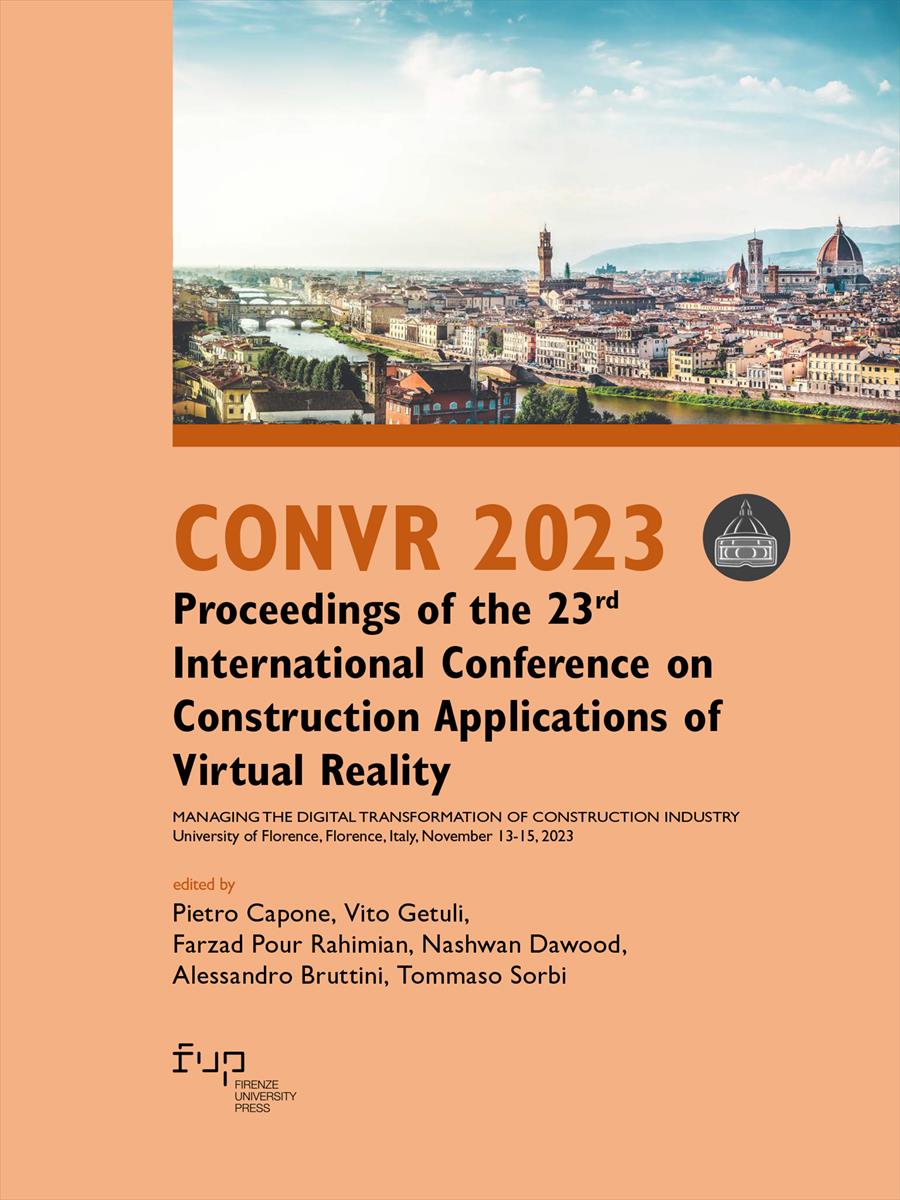- CONVR 2023 - Proceedings of the 23rd International Conference on Construction Applications of Virtual Reality
- Edited by Pietro Capone, Vito Getuli, Farzad Pour Rahimian, Nashwan Dawood, Alessandro Bruttini, Tommaso Sorbi
Automated Extraction of Bridge Gradient from Drawings Using Deep Learning
- Hakan Bayer
- Benedikt Faltin
- Markus König
- © 2023 Author(s) |
- CC BY-NC 4.0
- DOI: 10.36253/979-12-215-0289-3.68
Digital methods such as Building Information Modeling (BIM) can be leveraged, to improve the efficiency of maintenance planning of bridges. However, this requires digital building models, which are rarely available. Consequently, these models must be created retrospectively, which is time-consuming when done manually. Naturally, there is a great interest in the industry to automate the process of retro-digitization. This paper contributes to these efforts by proposing a multistage pipeline to automatically extract the gradient of a bridge from pixel-based construction drawings using deep learning. The bridge gradient, a key element of the structure’s axis, is critical for describing the elevation profile and axis slope. This information is implicitly contained in the longitudinal view of bridge drawings as gradient symbols. To extract this information, the well-established object detection model YOLOv5 is employed to locate the gradient symbols inside the drawings. Subsequently, EasyOCR and heuristic rules are applied to extract the relevant gradient parameters associated with each detected symbol. The extracted parameters are then exported in a machine-interpretable format to facilitate seamless integration into other applications. The results show a promising 98% accuracy in symbol detection and an overall accuracy of 70%. Consequently, the pipeline represents a significant advance in automating the retro-digitization process for existing bridges by reducing the time and effort required
- Keywords:
- Building Information Modeling,
- Computer Vision,
- Deep Learning,
- Symbol Detection,
- Optical Character Recognition,
- Construction Drawings,
Ruhr-University Bochum, Germany - ORCID: 0000-0002-8192-228X
Ruhr-University Bochum, Germany - ORCID: 0000-0003-1354-7817
Ruhr-University Bochum, Germany - ORCID: 0000-0002-2729-7743
- Akanbi, T., & Zhang, J. (2022). Semi-Automated Generation of 3D Bridge Models from 2D PDF Bridge Drawings. In F. Jazizadeh, T. Shealy, & M. J. Garvin (Eds.), Construction Research Congress 2022 (pp. 1347–1354). DOI: 10.1061/9780784483961.141
- Baek, Y., Lee, B., Han, D., Yun, S. and Lee, H. (2019). Character Region Awareness for Text Detection. In the Proceedings of the IEEE/CVF Conference on Computer Vision and Pattern Recognition, 19365-19374. DOI: 10.1109/CVPR.2019.00959
- Borrmann, A., König, M., Koch, C., & Beetz, J. (2018). Building Information Modeling: Why? What? How? In A. Borrmann, M. König, C. Koch & J. Beetz (Eds.), Building Information Modeling. Springer. DOI: 10.1007/978-3-319-92862-3_1
- Durdyev, S., Ashour, M., Connelly, S., & Mahdiyar, A. (2022). Barriers to the implementation of Building Information Modelling (BIM) for facility management. Journal of Building Engineering, 46, Article 103736. DOI: 10.1016/j.jobe.2021.103736
- Faltin, B., Schönfelder, P., & König, M. (2023). Inferring Interconnections of Construction Drawings for Bridges Using Deep Learning-based Methods. In E. Hjelseth, S. F. Sujan & R. J. Scherer (Eds.), ECPPM 2022-eWork and eBusiness in Architecture, Engineering and Construction 2022 (pp. 343-350). CRC Press. DOI: 10.1201/9781003354222
- Jocher, G., Chaurasia, A., Stoken, A., Borovec, J., Kwon, Y., Michael, K., TaoXie, Fang, J. imyhxy, Lorna, Zan Yifu, Wong, C., V, A., Montes, D., Wang, Z., Fati, C., Nadar, J., Laughing, … Jain, M. (2022). ultralytics/yolov5: v7.0 - YOLOv5 SOTA Realtime Instance Segmentation. Zenodo. DOI: 10.5281/zenodo.3908559
- Kim, S., Park, S., Kim, H., & Yu, K. (2021). Deep Floor Plan Analysis for Complicated Drawings Based on Style Transfer. Journal of Computing in Civil Engineering, 35(2), Article 04020066. DOI: 10.1061/(ASCE)CP.1943-5487.0000942
- Mafipour, M. S., Ahmed, D., Vilgertshofer, S., & Borrmann, A. (2023). Digitalization of 2D Bridge Drawings Using Deep Learning Models. The 30th EG-ICE: International Conference on Intelligent Computing in Engineering. https://www.ucl.ac.uk/bartlett/construction/sites/bartlett_
- construction/files/digitalization_of_2d_bridge_drawings_using_deep_learning_models.pdf
- Moreno-García, C. F., Elyan, E., & Jayne, C. (2019). New trends on digitisation of complex engineering drawings. Neural computing and Applications, 31, 1695-1712. DOI: 10.1007/s00521-018-3583-1
- Poku-Agyemang, K. N., & Reiterer, A. (2023). 3D Reconstruction from 2D Plans Exemplified by Bridge Structures. Remote Sensing, 15(3), 677. DOI: 10.3390/rs15030677
- Robbins, H., & Monro, S. (1951). A Stochastic Approximation Method. The Annals of Mathematical Statistics, 22(3), 400–407. http://www.jstor.org/stable/2236626
- Schönfelder, P., Aziz, A., Faltin, B., & König, M. (2023). Automating the retrospective generation of As-is BIM models using machine learning. Automation in Construction, 152, Article 104937. DOI: 10.1016/j.autcon.2023.104937
- Shi, B., Bai, X., & Yao, C. (2017). An End-to-End Trainable Neural Network for Image-Based Sequence Recognition and Its Application to Scene Text Recognition. IEEE transactions on pattern analysis and machine intelligence, 39(11), 2298–2304. DOI: 10.1109/TPAMI.2016.2646371
- Wei, C., Gupta, M., & Czerniawski, T. (2022). Automated Wall Detection in 2D CAD Drawings to Create Digital 3D Models. Proceedings of the 39th International Symposium on Automation and Robotics in Construction (pp. 152-158). IAARC Publications. DOI: 10.22260/ISARC2022/0023
- Zhao, Y., Deng, X., & Lai, H. (2020). A Deep Learning-Based Method to Detect Components from Scanned Structural Drawings for Reconstructing 3D Models. Applied Sciences, 10(6), 2066. DOI: 10.3390/app10062066
- Zhao, Y., Deng, X., & Lai, H. (2021). Reconstructing BIM from 2D structural drawings for existing buildings. Automation in Construction, 128, Article 103750. DOI: 10.1016/j.autcon.2021.103750
Chapter Information
Chapter Title
Automated Extraction of Bridge Gradient from Drawings Using Deep Learning
Authors
Hakan Bayer, Benedikt Faltin, Markus König
DOI
10.36253/979-12-215-0289-3.68
Peer Reviewed
Publication Year
2023
Copyright Information
© 2023 Author(s)
Content License
Metadata License
Bibliographic Information
Book Title
CONVR 2023 - Proceedings of the 23rd International Conference on Construction Applications of Virtual Reality
Book Subtitle
Managing the Digital Transformation of Construction Industry
Editors
Pietro Capone, Vito Getuli, Farzad Pour Rahimian, Nashwan Dawood, Alessandro Bruttini, Tommaso Sorbi
Peer Reviewed
Publication Year
2023
Copyright Information
© 2023 Author(s)
Content License
Metadata License
Publisher Name
Firenze University Press
DOI
10.36253/979-12-215-0289-3
eISBN (pdf)
979-12-215-0289-3
eISBN (xml)
979-12-215-0257-2
Series Title
Proceedings e report
Series ISSN
2704-601X
Series E-ISSN
2704-5846
